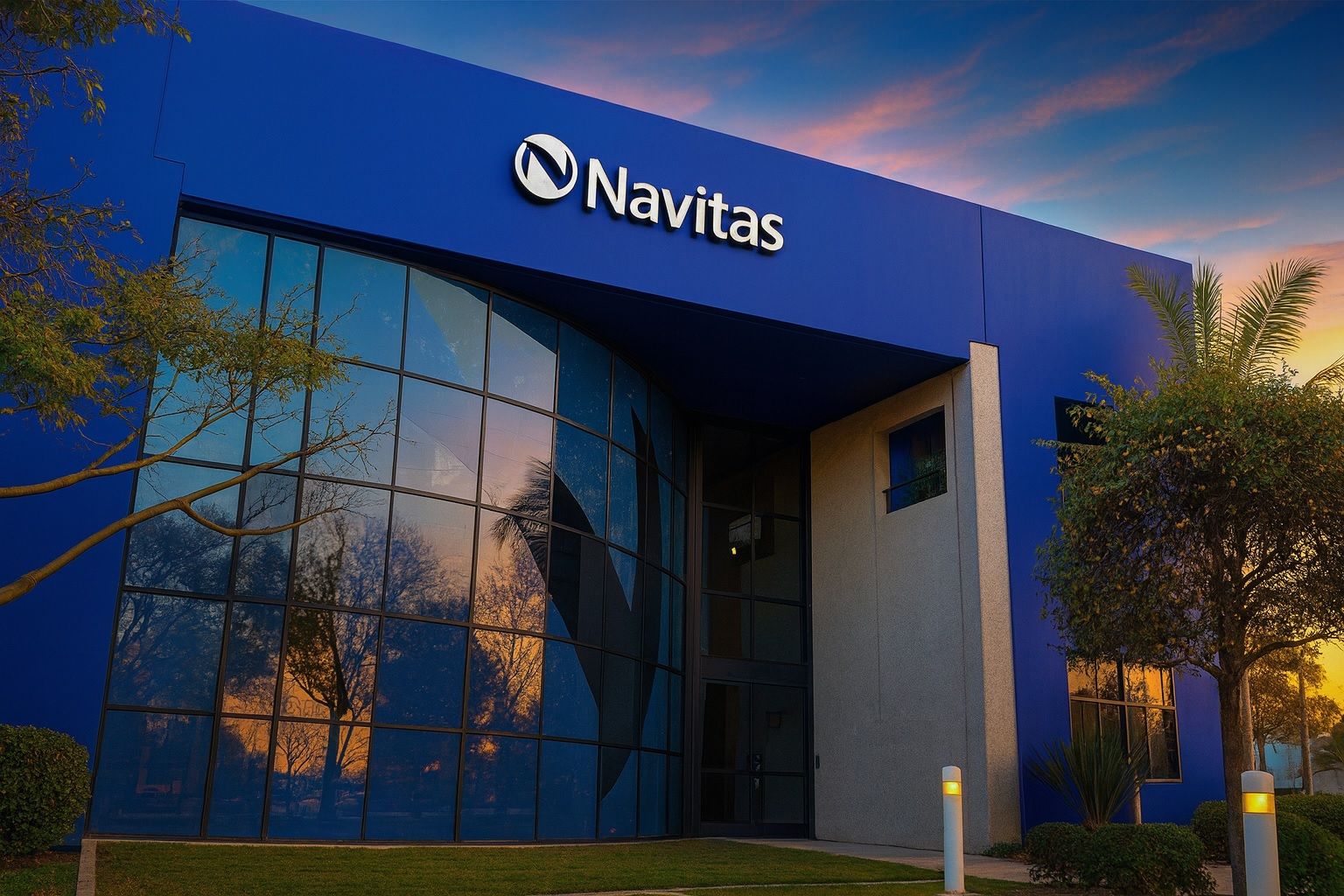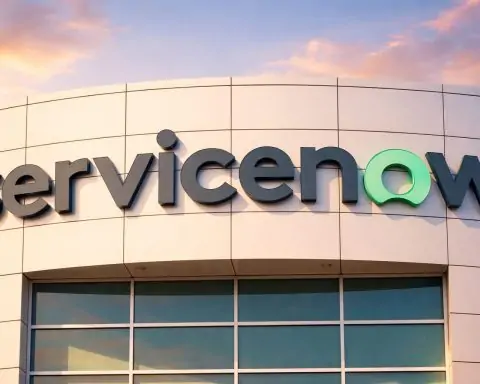- Massive jump on AI news: Navitas Semiconductor (NASDAQ: NVTS) shot up 21% on Oct 13, 2025 (closing ~$9.97) after unveiling advanced GaN/SiC chips for NVIDIA’s new AI data-center architecture [1] [2]. By after-hours the stock was trading ~27% higher (~$12.71) [3]. Earlier, NVTS had been surging – up ~179% year-to-date (nearly +300% over 12 months) as investors bet on its AI and EV power chips [4].
- Nvidia partnership: Navitas announced on Oct 13 that it has “developed advanced 800 VDC GaN and SiC power devices” to enable NVIDIA’s 800 VDC data-center power architecture [5] [6]. This next-gen “AI factory” power plan shifts from legacy 54V racks to 800V rails, promising higher efficiency, fewer conversion stages, and MW-scale rack power [7] [8]. Navitas’ new 100V GaN FETs and 650V GaN/SiC chips are “purpose-built” for NVIDIA’s 800V design [9] [10]. CEO Chris Allexandre said Navitas is “proud to support this shift with advanced GaN and SiC power solutions that enable the efficiency, scalability, and reliability required by next-generation data centers” [11].
- GaN/SiC tech edge: Navitas is one of the very few pure-play GaN/SiC power-chip companies [12]. Its GaN power ICs integrate transistor, drive and sensing, enabling much faster switching and greater efficiency. The firm notes GaN chips can boost efficiency by up to 40% and switch 100× faster than silicon [13], which has revolutionized mobile chargers and promises similar gains in data-center power. Navitas’ customer list spans major PC and EV makers (Dell, Lenovo, Samsung, Xiaomi, BYD, Changan) [14], and in May 2025 it already partnered with Nvidia on more efficient data-center power systems [15].
- Financials and outlook: In Q2’25 (reported Aug 2025) Navitas had only $14.5M in revenue (down 29% YoY) and a GAAP loss of $21.7M [16] [17]. Its 2024 sales were ~$83M [18], far below the $308M by 2024 promised at its 2021 SPAC IPO [19]. Wall Street now projects 2025 revenue around $48–54M (–40% YoY) and net losses expanding (to ~$116M) before rebounding as Nvidia chips ramp. By 2026 analysts forecast ~+$53M sales, and by 2027 ~$95M (as NVIDIA-powered products ship) [20]. Management expects Q3’25 sales ~$10M [21] and has ample cash (~$161M) after a $100M share offering [22] [23]. Navitas has no debt and a “current ratio of 5.6” (per Deutsche Bank) [24], underpinning confidence despite the current downturn.
- Leadership & strategy: In Sept 2025 co-founder Gene Sheridan moved from CEO to Executive Chair, and Chris Allexandre (ex-Renesas power chief) became CEO [25] [26]. Allexandre’s mandate is clear: pivot away from low-margin chargers and focus on AI data centers, EVs and energy infra. The recent moves (Nvidia tie-up, new 8″ wafer fab deal with Powerchip, $100M capital raise, new CEO) all align with this shift [27] [28]. As one analyst put it, Navitas may be “one of the most important growth stories of the decade” given booming AI and EV power needs [29].
- Stock valuation & risks: NVTS is up ~179% YTD, giving it a ~$2.1B market cap [30] but with negative earnings. It trades around 30–31× forward sales [31] (vastly above the ~9× industry average). Short interest is high (~25-28% of float [32]), reflecting volatility. Analysts are divided: some have raised price targets after the Nvidia news (e.g. Rosenblatt’s Buy, $8 target [33]) and called the tie-up a “strong endorsement” [34], while others caution much of the upside is already baked into the stock. Of 8 tracked analysts, 3 rate NVTS Buy, 3 Hold and 2 Sell, with an average target (~$5.65 [35]) well below current levels. In short, the stock is richly valued on future prospects – one strategist warns the “future story” (NVIDIA chips, growth) may already be priced in [36].
In-Depth Analysis: Navitas Semiconductor (NVTS) is a fabless chipmaker (founded 2014) specializing in wide-bandgap power electronics. It pioneered “GaNFast” ICs that monolithically integrate GaN transistors with control circuits [37]. These allow much smaller, more efficient power supplies (e.g. fast chargers) because GaN can run at higher frequencies with lower losses. In 2022 the company also acquired GeneSiC, adding high-voltage SiC diodes and MOSFETs for EV and energy applications. By mid-2025, Navitas’ revenue mix was split among fast chargers (for phones/laptops), industrial, solar, EV, and (latest) data centers [38] [39].
However, growth stalled in 2024–25. Navitas had warned that mobile/consumer demand was softening, EV/solar customers were destocking, and its former China distributor left [40]. With 60% of sales from China, ongoing tariff uncertainties also weighed on orders. The result: Q2’25 sales fell to $14.5M (–29% YoY) [41] [42], and for 2025 analysts now expect ~ $48–54M full-year (–40% from 2024) [43]. The Q2 loss was $0.05 per share (non-GAAP) [44], and the company is burning cash on R&D. Navitas’ strategy has been to ride industry upcycles: it surged in 2022-23 on GaN/SiC hype, but now is in a transition. Management has shifted resources out of low-margin chargers into higher-power markets (AI, EV, grid) [45] [46]. The $100M capital raise in Q2 was earmarked for funding this pivot, including financing the new Powerchip 8″ GaN fab [47] which should slash production costs and boost volumes. Sheridan (now Chairman) has said Navitas aims to create “an even bigger new market encompassing both GaN and SiC for AI data centers” with a potential ~$2.6 billion annual market by 2030 [48].
Nvidia Alliance and AI Data Centers: The big recent catalyst is Nvidia. In May 2025 Navitas first announced a collaboration to make power supplies more efficient for Nvidia’s next-gen data centers [49]. This kicked off optimism. Now, Nvidia has publicly pushed an “AI factory” concept: future servers using 800VDC power rails (instead of today’s 48–54V), requiring new power architectures. Navitas has stepped up to design chips for every stage of this architecture. Its Oct 13 PR detailed new 100V GaN FETs (for VRM boards), 650V GaN FETs, and high-voltage SiC devices, all tuned for the 800V plan [50] [51]. The science: using 800V DC from the grid to racks cuts out multiple AC/DC conversion steps, greatly improving efficiency and reducing copper losses [52] [53]. In plain terms, Navitas’ GaN/SiC chips “cover the entire power conversion chain” of an 800V data center – from utility substation (13.8kV) to rack-level 48V GPU rails [54]. This multi-stage capability means Navitas can potentially grab a slice of every segment of the new AI power stack. Indeed, Allexandre pointed out that NVIDIA’s shift “requires the efficiency, scalability and reliability” that GaN/SiC can uniquely provide [55].
Investors clearly loved the announcement: NVTS spiked in after-hours on Oct 13 as markets digested the news [56]. Seeking Alpha notes shares jumped ~26% premarket Oct 14 [57]. The rally was further stoked by broad tech optimism (even a reported easing in US-China trade tensions) [58]. But the driver was the AI story. As one TS2 analyst puts it, the Nvidia endorsement “shot [Navitas] into orbit” in early 2025 [59], transforming it from a charger specialist into a potential “AI arms dealer” alongside chip giants.
Current Valuation & Sentiment: NVTS is now well above its 50-day and 200-day moving averages [60], indicating strong momentum but also an overbought technical condition (RSI ~70–77) [61]. Short sellers have been squeezed in the rally (short interest ~25–28% of float [62]). The stock’s beta is very high (~3.0) [63], underscoring volatility. At ~$10 (Oct 13 close) and ~$12 in after-hours, NVTS trades far above Wall Street price targets. Most analysts are skeptical that all current expectations are justified. Rosenblatt reaffirmed Buy (with an $8 target) [64], but Deutsche Bank even cut its rating to Hold while lifting its target only to $7 [65]. Deutsche Bank called the Nvidia tie-up a “strong endorsement” of Navitas, yet modeled just $10–45M of cumulative Nvidia-related revenue by 2027 [66] – a fraction of the company’s revenue. Others like Needham remain positive (Buy) but lowball the target ($3) citing solar/China headwinds [67]. On average, eight tracked analysts have a consensus target ~ $5.65 [68], implying a drop of ~50% from current levels. Zacks recently rated NVTS a “Hold,” noting its forward P/S (~27x) is extremely high for the sector [69].
In short, the bull case is that Navitas has finally found its market: as data centers transition to GaN/SiC, Navitas could capture multi-hundred-million-dollar annual sales. If NVIDIA’s vision materializes, some estimate a $2.6B AI data-center GaN/SiC market by 2030 [70] [71], and Navitas is well-positioned as one of the few pure-play suppliers. Conversely, the bear case is that Navitas is still small (2025 sales ~$50M) and years away from profitability; much of the “AI premium” is already priced in. If its chips face delays or if NVIDIA’s plan evolves differently, NVTS could struggle to meet sky-high growth expectations.
Forecast & Outlook: Wall Street expects Navitas to remain a deep-tech startup in 2025, with revenues roughly halved YoY and losses widening [72]. Only in 2027, when Nvidia-powered units might ship, do forecasts show a major jump (to ~$95M rev) [73]. Even then, net losses could still be large (Motley Fool models ~$68M loss in 2027) [74]. The market is banking on that future scenario: the stock prices in much of the 2027 bull case. With Q3 results (Nov 3, 2025) approaching, all eyes will be on any news of design wins or delays.
Bottom Line: Navitas has emerged as one of the most talked-about small-caps in power semiconductors, thanks to the Nvidia AI buzz. Experts quote it as potentially an “important growth story of the decade” [75]. However, they caution the high valuation may be pricing in nearly every optimistic outcome [76]. For now, NVTS is riding a tech wave – but investors should weigh that against the risk that fundamentals (small sales base, big losses) have some catching up to do.
Sources: Company filings and press releases [77] [78]; news reports from Reuters/TradingView [79], Seeking Alpha [80], Investing.com [81] [82] [83]; financial analysis sites (Finviz, MarketBeat) via TS2.tech [84] [85]; Motley Fool and TS2.tech analysis [86] [87]. All quotes and data are from the cited sources.
References
1. www.sharewise.com, 2. www.tradingview.com, 3. www.tradingview.com, 4. ts2.tech, 5. navitassemi.com, 6. www.tradingview.com, 7. navitassemi.com, 8. uk.investing.com, 9. navitassemi.com, 10. uk.investing.com, 11. uk.investing.com, 12. ts2.tech, 13. ts2.tech, 14. finviz.com, 15. finviz.com, 16. ir.navitassemi.com, 17. ts2.tech, 18. finviz.com, 19. finviz.com, 20. ts2.tech, 21. ir.navitassemi.com, 22. ir.navitassemi.com, 23. ts2.tech, 24. ts2.tech, 25. ts2.tech, 26. ts2.tech, 27. ts2.tech, 28. ts2.tech, 29. ts2.tech, 30. ts2.tech, 31. ts2.tech, 32. ts2.tech, 33. ts2.tech, 34. ts2.tech, 35. ts2.tech, 36. ts2.tech, 37. ts2.tech, 38. finviz.com, 39. ts2.tech, 40. finviz.com, 41. ir.navitassemi.com, 42. ts2.tech, 43. ts2.tech, 44. ts2.tech, 45. ir.navitassemi.com, 46. ts2.tech, 47. ts2.tech, 48. ir.navitassemi.com, 49. finviz.com, 50. navitassemi.com, 51. uk.investing.com, 52. navitassemi.com, 53. uk.investing.com, 54. ts2.tech, 55. uk.investing.com, 56. uk.investing.com, 57. seekingalpha.com, 58. www.sharewise.com, 59. ts2.tech, 60. ts2.tech, 61. ts2.tech, 62. ts2.tech, 63. ts2.tech, 64. ts2.tech, 65. ts2.tech, 66. ts2.tech, 67. ts2.tech, 68. ts2.tech, 69. ts2.tech, 70. ir.navitassemi.com, 71. ts2.tech, 72. ts2.tech, 73. ts2.tech, 74. ts2.tech, 75. ts2.tech, 76. ts2.tech, 77. ir.navitassemi.com, 78. ts2.tech, 79. www.tradingview.com, 80. seekingalpha.com, 81. uk.investing.com, 82. uk.investing.com, 83. uk.investing.com, 84. ts2.tech, 85. ts2.tech, 86. ts2.tech, 87. ts2.tech







